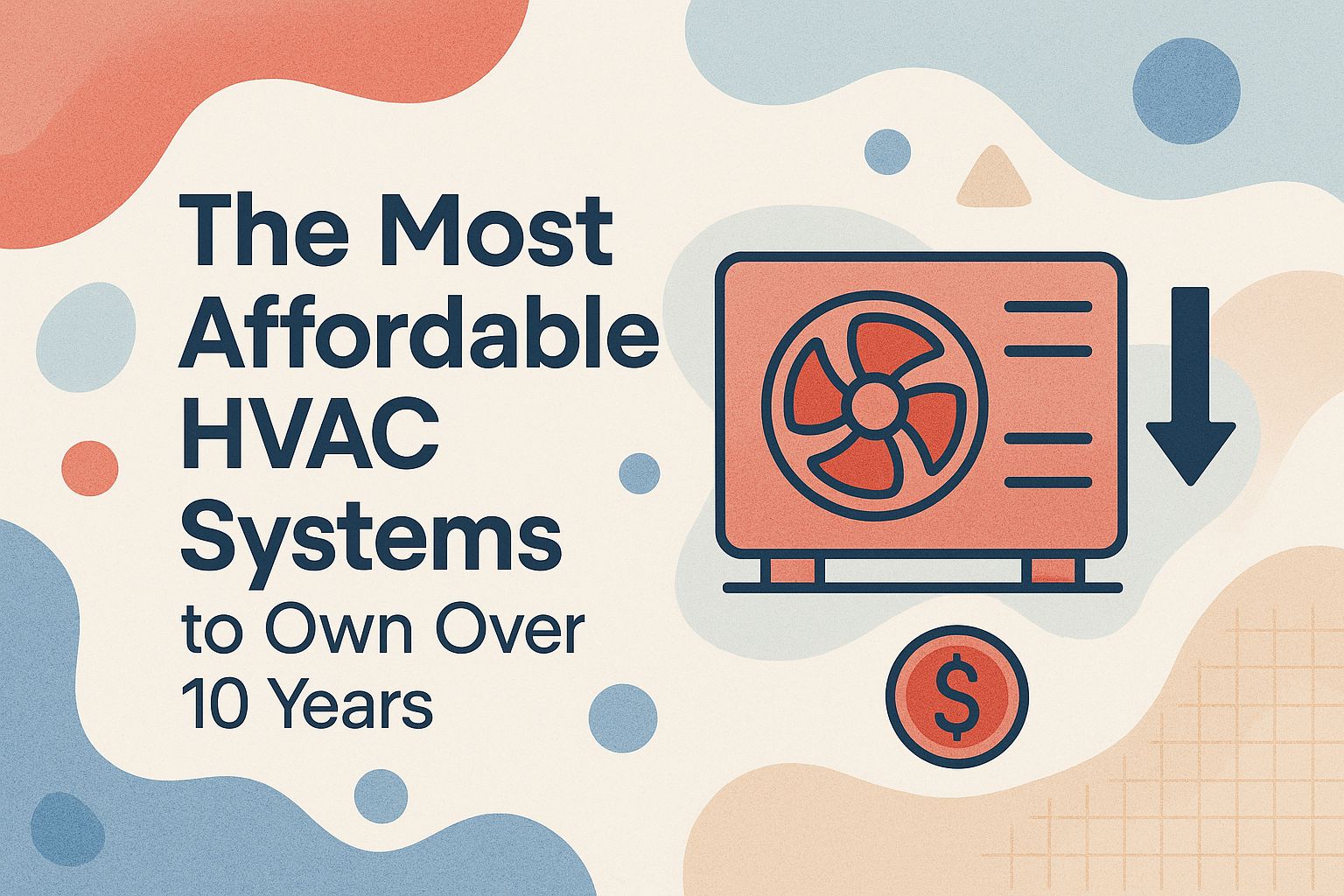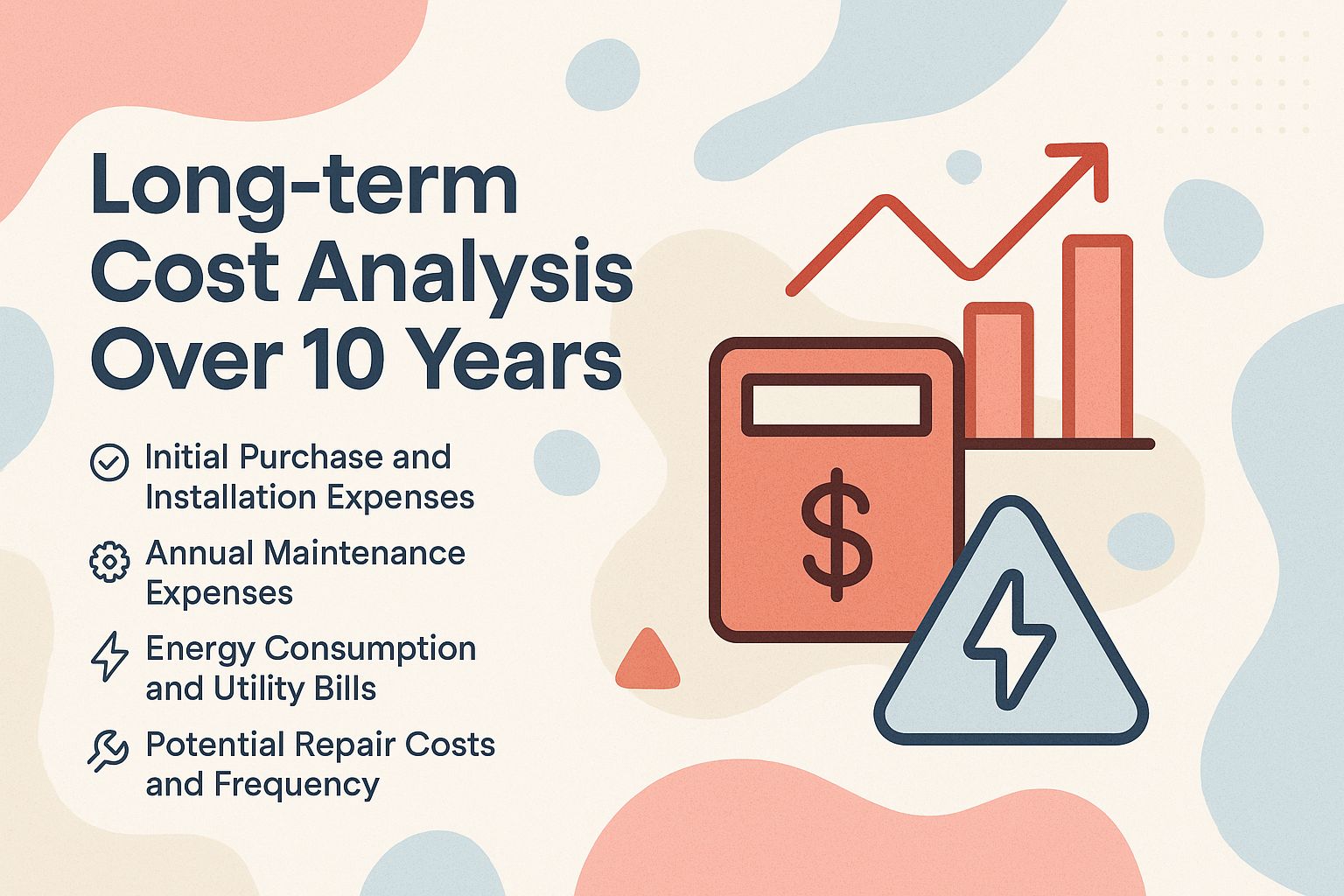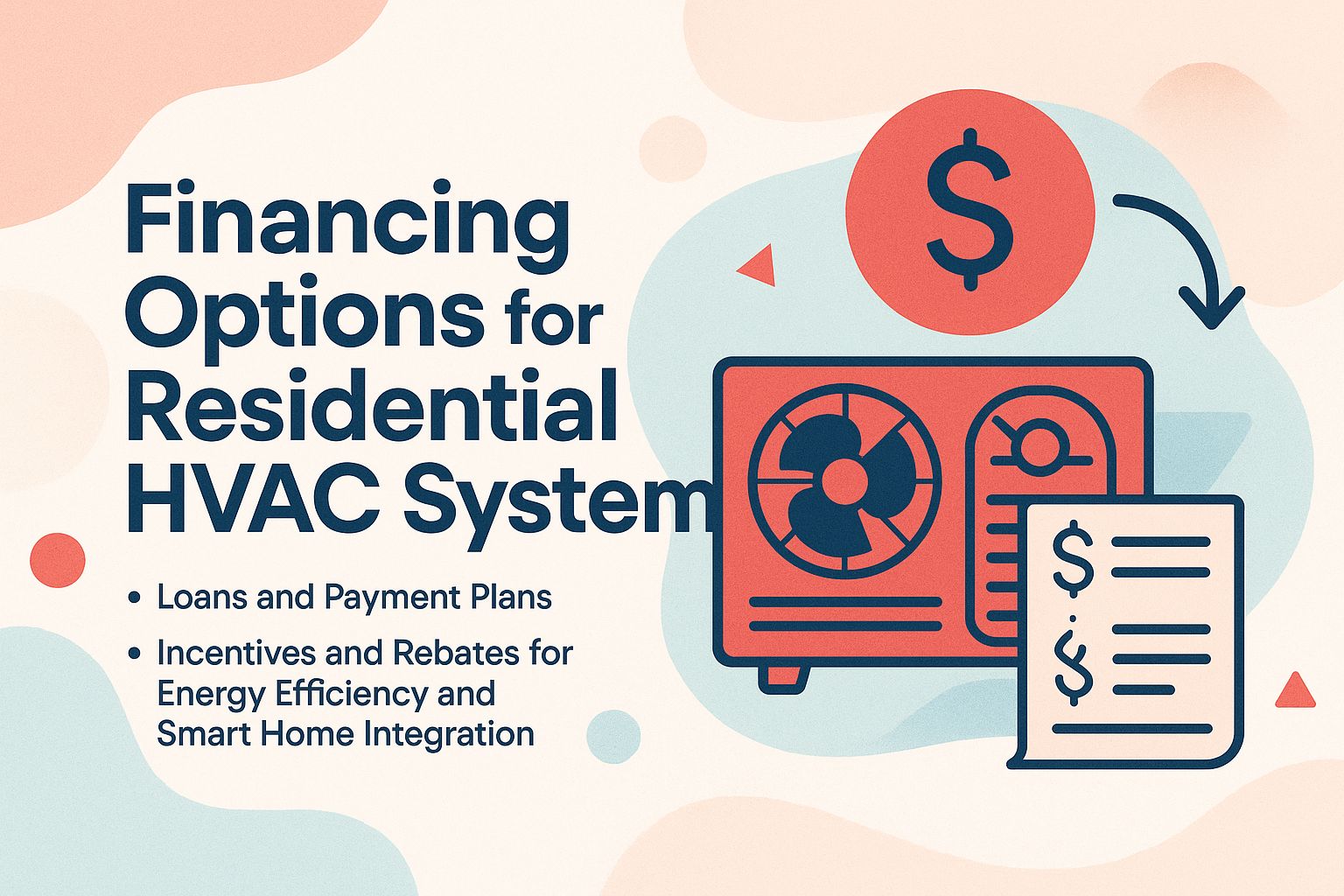
The Most Affordable HVAC Systems to Own Over 10 Years
Want to stay cool without spending too much money? Choosing the right residential HVAC system can save you money for years to come. With rising energy costs, it’s important to know what affects HVAC prices. This guide looks at different kinds of affordable systems, their main features, and the top choices you can find. Find out about choices that will cool your home and save you money for the next ten years by looking at energy-saving improvements and financing options.
Importance of HVAC Systems
Heating, Ventilation, and Air Conditioning (HVAC) systems are essential for keeping homes comfortable. They regulate the temperature, clean the air inside, save energy, and control the environment.
Controlling the climate is important for comfort, work efficiency, and health. Efficient heating and cooling systems maintain stable temperatures, preventing extremes that can stress the body, and offer significant long-term cost savings.
Air purification features in modern HVAC units filter out allergens and pollutants. For instance, studies show that homes equipped with HEPA filters experience significantly lower incidences of asthma and respiratory issues.
By investing in an energy-saving HVAC system with a high seasonal energy efficiency ratio (SEER), homeowners improve comfort and create a healthier living space, which leads to significant long-term health benefits.
Factors Affecting HVAC Costs
The total cost of HVAC systems depends on different things: the price of installing them, how energy efficient they are, and the expense of keeping them in good condition.
For instance, installation fees can vary by region, typically ranging from $5,000 to $10,000, depending on system complexity and labor rates.
Energy efficiency ratings, indicated by SEER (Seasonal Energy Efficiency Ratio), are important; systems with a higher SEER rating might be more expensive initially but can reduce energy costs over time.
Regular maintenance is essential; an annual service visit can cost between $100 and $300, ensuring optimal performance, system durability, and longevity.
When budgeting, consider these elements to make an informed decision.
Types of HVAC Systems
Picking the right HVAC system with intelligent thermostats is essential for achieving top performance and comfort in homes and workplaces. Understanding the 4 main types of HVAC systems can help make informed decisions tailored to your needs.

Central Air Conditioning Systems
Central air conditioning systems, known as central air units, are commonly chosen for cooling an entire house, usually offering stable temperature control and improved comfort.
When choosing a central AC system, consider specifications like cooling capacity (measured in BTUs), average costs ranging from $3,000 to $7,000, and SEER (Seasonal Energy Efficiency Ratio) ratings, which reflect efficiency.
For instance, a system with a SEER rating above 16 is more energy-efficient. Popular brands include Carrier, known for their reliability, and Trane, which offers high-performance options.
Consulting an HVAC professional can help you determine the best system for your home’s size and cooling needs.
Heat Pumps
Heat pumps are devices that offer heating in winter and cooling in summer, making them a cost-effective option for keeping rooms comfortable all year.
They work by transferring heat rather than generating it, offering higher efficiency than traditional systems.
Efficiency is often measured using the Heating Seasonal Performance Factor (HSPF), where higher ratings indicate better performance, contributing to lower operating costs. For instance, an HSPF of 10 can significantly lower your energy bills compared to conventional heaters.
Prices for heat pump installations range from $4,000 to $10,000, depending on the model and installation specifics. Compared to traditional heating systems like gas furnaces, which typically cost less upfront but have higher operating costs, heat pumps can be a more economical long-term investment.
Mini-Split Systems
Mini-split systems, also known as ductless systems, offer a flexible and energy-efficient solution for homes without ductwork, allowing for targeted heating and cooling.
Installation costs for mini-split systems typically range from $2,000 to $5,000, depending on the number of zones needed and the complexity of the installation.
These systems boast efficiency ratings often exceeding 20 SEER (Seasonal Energy Efficiency Ratio), significantly reducing energy bills compared to traditional HVAC systems. They’re particularly suitable for home additions, basements, or areas where conventional ducting is impractical.
For instance, an 800-square-foot addition can benefit from a single-zone system, providing custom comfort with lower energy consumption.
Window Units
Window air conditioning units are an affordable HVAC systems option for cooling individual rooms, often costing between $150 and $500, depending on BTU capacity.
When selecting a window unit, consider BTU ratings, which determine the cooling power needed for your space.
For rooms up to 150 sq. ft., a unit with 5,000-6,000 BTUs is typically sufficient. Check energy efficiency ratings (EER); units with a higher EER can lower energy bills.
On average, operating costs range from $30 to $100 per season. Compared to central air systems, window units provide targeted cooling for small spaces, often translating to significant energy savings due to their lower initial investment and operational costs.
Key Features of Affordable HVAC Systems
When choosing a budget-friendly HVAC system, focus on important features that lead to lasting cost savings and energy efficiency.

Energy Efficiency Ratings (SEER and HSPF)
Energy efficiency ratings, like SEER for cooling and HSPF for heating, are important for knowing how much energy you can save with HVAC systems, often influencing return on investment (ROI).
The SEER (Seasonal Energy Efficiency Ratio) rating evaluates cooling performance, with a benchmark of SEER 14 considered efficient. Higher ratings indicate better energy use, potentially lowering electricity bills significantly over time.
On the heating side, the HSPF (Heating Seasonal Performance Factor) measures heating efficiency, where HSPF 8 is ideal. For homeowners, selecting an HVAC system with these ratings can save hundreds annually in operational costs while also contributing to a reduced environmental footprint. For an extensive analysis of this trend, our comprehensive study on HVAC systems’ energy consumption examines how these ratings impact long-term savings and sustainability.
Initial Costs vs. Long-term Savings
While initial costs for HVAC systems can be substantial, the long-term savings in energy bills often justify the upfront investment, particularly with energy-efficient upgrades.
Consider this: a high-efficiency system may cost around $8,000 to install but can save you approximately $500 annually on energy bills. Over a 10-year period, that equates to $5,000 in savings.
In contrast, a conventional system might only save about $250 per year, leading to just $2,500 over the same timeframe. Choosing an efficient model pays back its original price and saves money in the long run.
Looking at systems’ efficiency ratings, such as SEER, can help you make a better choice.
Durability and Maintenance Costs
Durability and maintenance requirements are key considerations that can significantly impact the overall cost-effectiveness of HVAC systems, affecting the lifespan of systems.
When evaluating HVAC systems, consider both durability ratings and maintenance schedules. Typically, high-efficiency units, while more expensive upfront, tend to have lower annual maintenance costs.
For instance, a well-maintained central air conditioning unit may cost around $150 annually, while neglecting maintenance can lead to expenses exceeding $500 in repairs, emphasizing the importance of professional installation and DIY maintenance.
The average lifespan is important; gas furnaces typically last 15-20 years, while window units usually last 10-15 years. Include these expenses in your budget to achieve lasting savings.
Top Affordable HVAC Systems on the Market
The HVAC market includes many popular brands that provide budget-friendly systems, each with specific advantages for different requirements, often highlighted in customer reviews. For a comprehensive view, one of the best HVAC brands in 2023 offers insights into the top contenders this year.
Trane: Overview and Costs
Trane offers a range of HVAC systems that are both affordable and efficient, making them a popular choice among homeowners for their Energy Star certification and long-standing reliability.
Their central air conditioning units typically range from $3,500 to $4,500, with energy efficiency ratings of up to 16 SEER. This ensures strong performance while keeping monthly utility bills in check.
Trane systems consistently receive high marks, with consumer satisfaction ratings between 4.2 and 4.7 out of 5, particularly for their durability and quiet operation.
The company backs its products with a 10-year parts warranty, giving buyers peace of mind. This mix of reasonable cost, high efficiency, and brand trust makes Trane a strong contender for homeowners seeking value.
Lennox: Overview and Costs
Lennox is known for innovative HVAC technology and designs that focus heavily on energy savings—appealing to eco-conscious buyers who also want long-term cost reductions.
Lennox units typically cost between $4,000 and $6,000, depending on the model and installation requirements.
Systems such as the Lennox SL28XCV come equipped with advanced smart thermostats and variable-capacity compressors, helping homeowners reduce energy consumption by up to 30% each month.
Many Lennox models feature advanced filtration systems, which improve indoor air quality—a key benefit for health-conscious households.
Most professional installations can be completed in a single day, minimizing disruption. Choosing Lennox not only cuts energy costs but also reduces your environmental footprint.
Goodman: Overview and Costs
Goodman stands out for delivering budget-friendly HVAC solutions without sacrificing reliability or efficiency. Many models qualify for energy rebates, further reducing ownership costs.
Goodman units are often priced between $2,500 and $4,500, making them one of the most affordable quality options on the market.
Customers consistently rate Goodman systems around 4.5 stars on major review platforms, noting their solid performance and dependable service life.
One of their most popular models, the Goodman GSX16, offers a 15 SEER rating and is well-suited for homes up to 2,000 square feet, helping homeowners save on monthly energy bills while staying within budget.
Goodman also includes a 10-year parts warranty, making them an excellent option for cost-conscious buyers who still want quality.
When choosing an affordable HVAC system, consider your home size; the EcoComfort model is ideal for spaces up to 2,000 square feet, providing optimal performance while staying within budget.
Long-term Cost Analysis Over 10 Years
Looking at HVAC costs over a decade helps homeowners understand the financial impact of their decisions, considering the return on investment (ROI) for residential HVAC.

Initial Purchase and Installation Expenses
Initial purchase and installation expenses can range significantly, typically between $3,000 and $10,000, depending on the system type, labor costs, and home requirements.
Several factors influence these costs. The type of HVAC system-central air conditioning, ductless mini-split HVAC systems, or heat pumps-can affect the price, with central systems often being the most expensive.
The difficulty of installation depends on your home’s current ductwork efficiency, insulation, and size. For example, adding a system in an already prepared home might cost around $3,500, whereas retrofitting can push costs close to $8,000.
Always request multiple quotes to make an informed decision.
Annual Maintenance Expenses
Annual maintenance expenses typically range from $150 to $300, essential for ensuring system longevity and efficiency through seasonal maintenance.
Regular maintenance, including DIY maintenance, is important because it can help avoid surprise repairs that might be much more expensive. For instance, maintaining your HVAC system can lower energy expenses by up to 30%. Ignoring maintenance might cause important parts to break, often costing over $1,000 in repairs.
Scheduled tasks include:
- Cleaning filters
- Inspecting thermostat calibration
- Checking for refrigerant leaks and types
Completing these tasks annually helps your systems endure longer and function more effectively.
Energy Consumption and Utility Bills
Energy consumption and corresponding utility bills vary widely based on HVAC system efficiency, including seasonal energy efficiency ratio (SEER) and heating seasonal performance factor (HSPF), with potential savings of up to 30% for high-efficiency units.
For instance, a standard central air conditioning unit consumes around 3,500 kWh annually, resulting in approximately $420 in utility costs at a rate of $0.12 per kWh. In contrast, a high-efficiency model may use just 2,500 kWh, costing only $300. This translates to a monthly savings of $10 for the homeowner.
To increase efficiency, think about buying programmable thermostats like Nest or Ecobee. These devices can lower energy use by changing temperatures according to your routine. Regular maintenance, such as changing filters and cleaning ducts, also contributes significantly to efficiency.
Potential Repair Costs and Frequency
Potential repair costs and repair frequency should also be factored into your HVAC budget, with average repairs ranging from $150 to $1,000 depending on issues.
Routine maintenance can significantly reduce unexpected repair costs. Changing or cleaning air filters every 1-3 months helps your system run smoothly.
A professional inspection at least once a year can catch issues early, often for about $100-$150. Keeping track of system age helps predict potential failures; for example, a unit over 15 years old may require more frequent repairs. Consider insurance considerations for older systems.
Sign up for a dependable HVAC service contract, including emergency service plans. These usually include emergency visits and regular maintenance, which can save you money and trouble.
Financing Options for Residential HVAC Systems
Looking into payment plans for HVAC systems can spread out the large initial expenses and improve energy audits and efficiency. In fact, there are specific financing programs that can help you afford a new HVAC system, making it easier to manage costs while upgrading your home’s energy performance.

Loans and Payment Plans
There are different loan and payment plan options for HVAC systems, including zero-interest financing programs offered by many contractors. Consider tax incentives when selecting financing options.
Homeowners can access financing through programs like the Energy Efficient Home Improvement Program (EEHIP), which offers flexible terms and rebates, enhancing the resale value of energy-efficient homes.
For instance, a typical loan might cover up to $20,000 with repayment periods ranging from 5 to 12 years. Contractors such as Home Depot and Lowe’s often provide special financing plans that feature deferred payments for the first six months.
Local utility companies might offer low-interest loans for energy-efficient improvements, helping with the cost of necessary installations or replacements. Review brand reputation and geographical location considerations when choosing systems.
Energy-Saving Discounts and Smart Home Installation Offers
Many states offer incentives and rebates for installing energy-efficient HVAC systems, potentially saving homeowners thousands over the lifespan of their systems, considering local climate considerations and HVAC regulations.
For example, California provides up to $1,000 in rebates for eligible high-efficiency heat pumps, considering noise levels and climate conditions. In New York, the Clean Heat program offers cash incentives ranging from $1,500 to $5,000 for air-source heat pump installations.
To maximize savings, check with your local utility company and apply during the installation process. Websites like EnergyStar.gov provide incentives sorted by state, helping you find eligible programs.
Review all choices to get the most out of financial help, like discounts for geothermal systems and money-saving methods.
About the Author
I’m Allen Chambers, a master electrician and licensed HVAC contractor with over 20 years of experience helping Florida homeowners design energy-efficient, high-performance HVAC solutions. As a contributor to HVAC Service Cost, I focus on making heating and cooling upgrades more affordable, sustainable, and stress-free for families across the state.




Leave a Reply